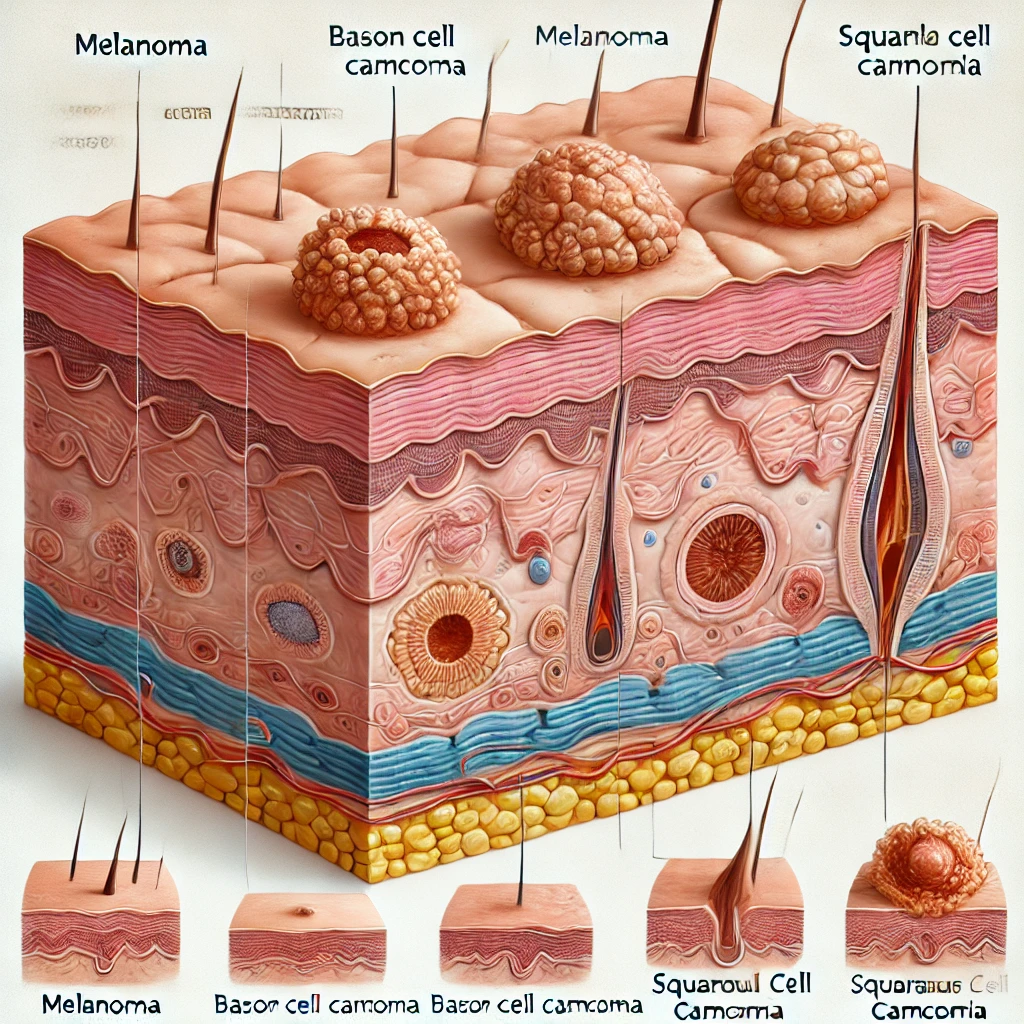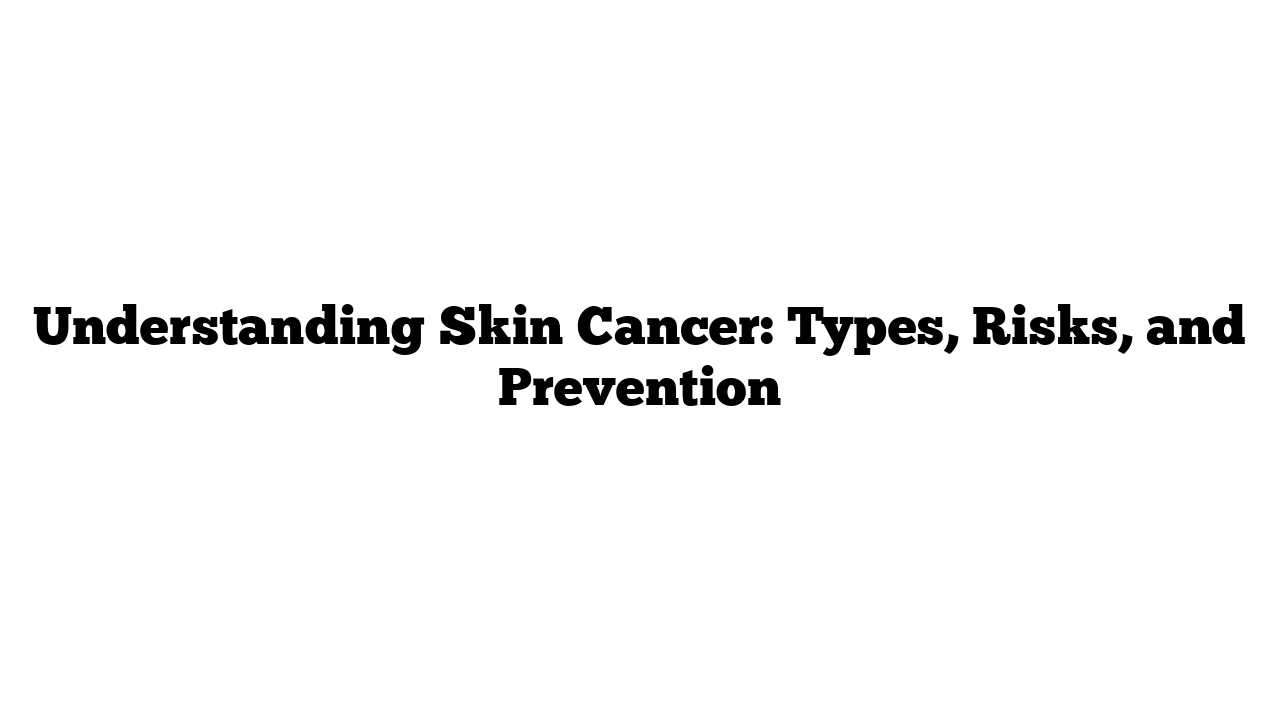Skin cancer is the most common type of cancer, affecting millions of individuals globally. In the USA, the rates have been steadily rising, but early detection and preventive measures can significantly reduce risks.

What is Skin Cancer?
Skin cancer develops when abnormal skin cells grow uncontrollably, often due to DNA damage from ultraviolet (UV) radiation. These cells can invade surrounding tissues and, in some cases, spread to other parts of the body.
Types of Skin Cancer
1. Basal Cell Carcinoma (BCC)
- Description: The most common and least aggressive type.
- Appearance: Pearly or waxy bumps, often on sun-exposed areas like the face.
- Risk Factors: Chronic sun exposure, fair skin, and a history of sunburns.
2. Squamous Cell Carcinoma (SCC)
- Description: Develops in the squamous cells of the epidermis.
- Appearance: Scaly red patches, open sores, or warty growths.
- Risk Factors: Prolonged UV exposure and weakened immune systems.
3. Melanoma
- Description: The most dangerous form of skin cancer, originating in pigment-producing melanocytes.
- Appearance: Irregularly shaped moles or dark patches with uneven color.
- Risk Factors: Genetics, tanning beds, and intense intermittent sun exposure.
Recognizing Skin Cancer
ABCDEs of Melanoma
- A: Asymmetry – One half doesn’t match the other.
- B: Border – Edges are irregular or blurred.
- C: Color – Uneven colors, including black, brown, and tan.
- D: Diameter – Larger than a pencil eraser.
- E: Evolving – Changes in size, shape, or color over time.
Other Warning Signs
- Persistent sores that do not heal.
- Unusual growths that bleed or itch.
- Changes in existing moles.
Risk Factors for Skin Cancer
- Excessive Sun Exposure
UV rays from the sun damage skin cells, leading to mutations. - Tanning Beds
Artificial UV radiation significantly increases the risk of melanoma. - Fair Skin
People with lighter skin have less melanin, making them more susceptible. - Family History
Genetic predisposition can play a significant role. - Immunosuppression
Conditions like HIV or medications post-organ transplant heighten risks.
Preventing Skin Cancer
1. Sunscreen is Essential
- Use a broad-spectrum SPF 30 or higher daily.
- Reapply every two hours, especially after swimming or sweating.
2. Seek Shade
Avoid peak sun hours (10 a.m. to 4 p.m.) to minimize UV exposure.
3. Protective Clothing
Wear wide-brimmed hats, UV-blocking sunglasses, and long-sleeved clothing.
4. Avoid Tanning Beds
The UV exposure from tanning beds is just as harmful as the sun.
5. Regular Skin Checks
Conduct monthly self-exams and see a dermatologist annually for a professional evaluation.
Treatment Options for Skin Cancer
1. Surgical Removal
- Excisional Surgery: Cuts out the tumor and surrounding tissue.
- Mohs Surgery: Removes cancer layer by layer while preserving healthy tissue.
2. Radiation Therapy
Often used for areas where surgery isn’t feasible.
3. Cryotherapy
Freezes and destroys small, early-stage cancers.
4. Topical Medications
Creams like imiquimod can treat superficial BCC or SCC.
5. Immunotherapy and Targeted Therapy
For advanced melanomas, drugs boost the immune system or target specific mutations.
Living with Skin Cancer
Skin cancer survivors should adopt lifelong habits for prevention and monitor their skin regularly. Emotional support through counseling or support groups can also help.
For expert tips and resources, visit medicaltimes.io.
Top 10 FAQs About Skin Cancer
1. What is the most common type of skin cancer?
Basal Cell Carcinoma (BCC) is the most common but least aggressive type.
2. Can dark-skinned individuals get skin cancer?
Yes, while less common, they can still develop skin cancer, especially on non-sun-exposed areas.
3. Is melanoma hereditary?
A family history increases the risk of melanoma.
4. How often should I apply sunscreen?
Apply every two hours and after swimming or sweating.
5. What’s the best way to detect skin cancer early?
Conduct monthly self-checks and see a dermatologist yearly.
6. Are tanning beds safer than sunbathing?
No, tanning beds significantly increase the risk of skin cancer.
7. Can sunscreen prevent skin cancer entirely?
It reduces the risk but doesn’t eliminate it completely.
8. What does a precancerous lesion look like?
It may appear as a scaly patch or rough spot that doesn’t heal.
9. How is skin cancer diagnosed?
Through a biopsy, where a sample of suspicious skin is examined under a microscope.
10. What is Mohs surgery?
A precise surgical technique removing skin cancer layer by layer.
